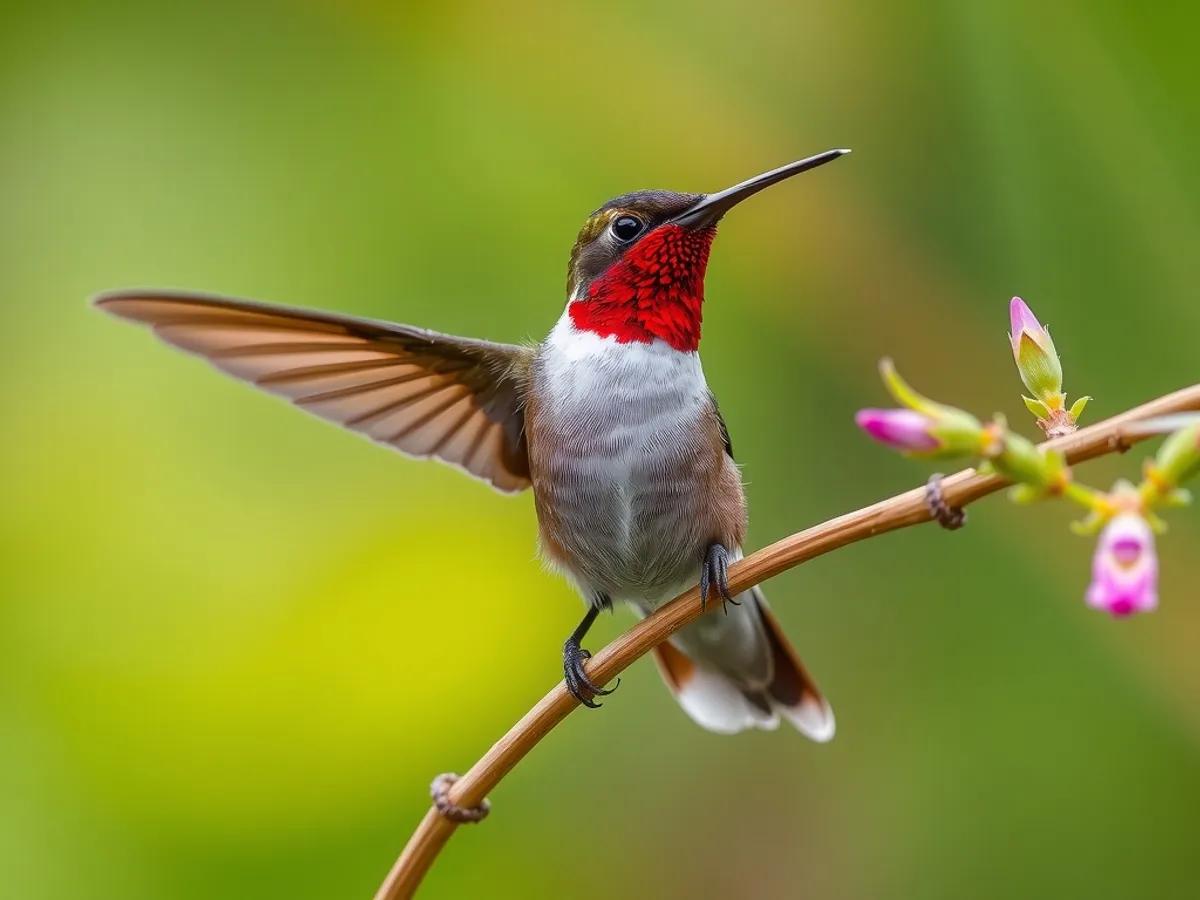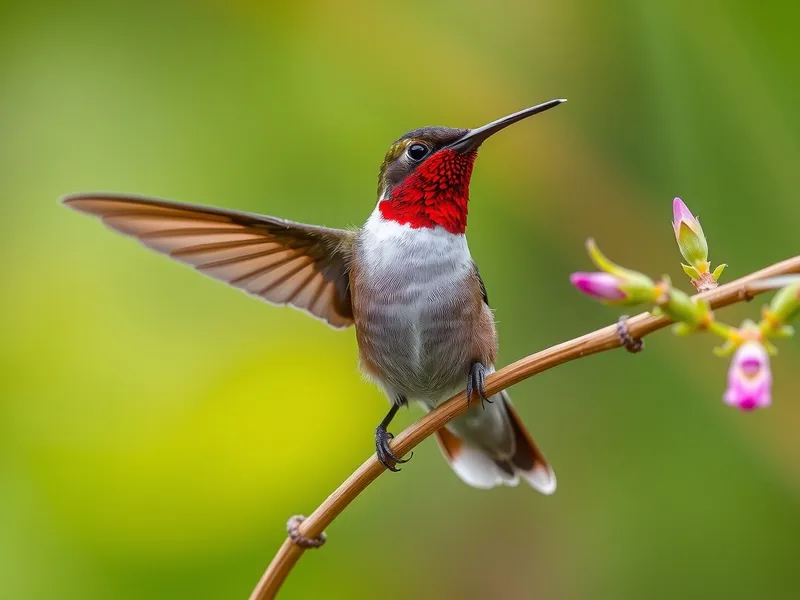
Ruby-throated Hummingbird
Archilochus colubris

Meet the Ruby-throated Hummingbird
The Ruby-throated Hummingbird is a small, vibrantly colored bird native to North and Central America. Males are easily recognized by their iridescent ruby-red throats, while females display a more subdued white and green plumage. These agile birds are renowned for their rapid wingbeats, which can reach up to 53 times per second, enabling them to hover in place and even fly backward. Ruby-throated Hummingbirds are solitary and highly territorial, especially around food sources such as flowering plants and feeders. Their remarkable migratory journey includes a nonstop flight of up to 800 kilometers (500 miles) across the Gulf of Mexico.
Classification
Bird
Habitat
Woodlands, gardens, meadows, and forest edges
Diet
Omnivore
Lifespan
3-5 years
Conservation
Least Concern
Weight
2.0-6.0 grams
📖Fascinating Facts
Pollination Experts
Ruby-throated Hummingbirds play a crucial role in pollinating many types of flowers as they feed on nectar, transferring pollen from one bloom to another.
High Metabolism
These birds have one of the highest metabolic rates among vertebrates, requiring them to eat frequently throughout the day to sustain their energy.
Remarkable Migration
Each year, they undertake long migratory journeys that include a nonstop flight over the Gulf of Mexico, a feat for such a small bird.
📋Detailed Description
The Ruby-throated Hummingbird (Archilochus colubris) is a diminutive bird, measuring 7–9 cm (2.8–3.5 in) in length and weighing only 2–6 g (0.07–0.21 oz), making it one of the smallest avian species in North America. Males are distinguished by their brilliant iridescent ruby-red gorget (throat patch), which appears dark in poor lighting, while females and juveniles lack this feature and display a white throat with faint streaking. Both sexes have metallic green upperparts and a forked tail, though the female's tail is rounded with white tips. Their wings are long and narrow, adapted for rapid, agile flight, and their bills are slender and slightly decurved, ideal for nectar feeding. The species possesses a highly specialized tongue with fringed, tubular tips that allow efficient nectar extraction. Ruby-throated Hummingbirds exhibit remarkable hovering ability, facilitated by a unique ball-and-socket joint at the shoulder, enabling the wings to rotate almost 180 degrees. They have the highest known metabolic rate among warm-blooded animals, requiring them to feed every 10–15 minutes during daylight hours. These hummingbirds are solitary outside of the breeding season, with individuals aggressively defending feeding territories. Their migratory behavior is notable for a trans-Gulf flight of up to 800 km (500 mi) without stopping, a feat requiring substantial fat reserves. Lifespan in the wild averages 3–5 years, though individuals have been recorded living up to 9 years.
💡 Did you know?
Despite their tiny size, Ruby-throated Hummingbirds can migrate nonstop across the Gulf of Mexico, flying over 800 kilometers without resting.
🔬Research & Sources
Wikipedia Summary
The ruby-throated hummingbird is a species of hummingbird that generally spends the winter in Central America, Mexico, and Florida, and migrates to Canada and other parts of Eastern North America for the summer to breed. It is the most common hummingbird in eastern North America, having population estimates of about 35 million in 2021.
Last Modified: 5/25/2025
🎭Behavior & Social Structure
Ruby-throated Hummingbirds are diurnal and exhibit a highly active foraging routine, visiting hundreds of flowers daily to consume nectar, their primary energy source. They supplement their diet with small arthropods such as spiders, gnats, and fruit flies, which provide essential proteins and nutrients. Feeding is accomplished by rapid tongue flicking (up to 13 times per second) and hovering flight, though they may also perch to feed when possible. Males are intensely territorial, especially during the breeding season, and will chase away intruders from favored feeding sites using aerial displays and vocalizations. Social interactions are minimal outside of courtship, as the species is generally solitary. At night or during periods of food scarcity, they enter a state of torpor, dramatically reducing metabolic rate and body temperature to conserve energy. Daily routines are dictated by the availability of food and daylight, with peak activity at dawn and dusk.
👶Reproduction & Life Cycle
Breeding occurs from late April to early August, with timing varying by latitude. Males perform elaborate courtship displays, including U-shaped flight patterns and rapid dives to attract females. After mating, the female assumes all nesting responsibilities. She constructs a tiny cup-shaped nest, often on a slender branch, using plant down, spider silk, and lichen for camouflage. Clutch size is typically two white eggs, each about 1.2 cm (0.5 in) long. Incubation lasts 12–14 days, after which the altricial chicks hatch and are fed by regurgitation. Fledging occurs 18–22 days post-hatching, though the young may remain near the nest for several days as they learn to forage. Females may raise one or two broods per season, depending on food availability and climate.
🛡️Adaptations & Survival
The Ruby-throated Hummingbird exhibits numerous adaptations for its nectarivorous lifestyle and migratory habits. Its rapid wingbeat (up to 53 beats per second) and unique shoulder anatomy allow for sustained hovering and backward flight. The long, extensible tongue with brush-like tips is specialized for extracting nectar from deep flowers. High metabolic rates are supported by a proportionally large heart (up to 2.5% of body mass) and efficient respiratory and circulatory systems. During migration, they accumulate fat reserves that can double their body weight, providing the energy necessary for long-distance flights. Their iridescent plumage is produced by microscopic platelets in the feathers that refract light, aiding in mate attraction and possibly predator avoidance. Torpor enables survival during cold nights or food shortages by reducing energy expenditure.
📚Research Sources
🎨Cultural Significance
Ruby-throated Hummingbirds hold a prominent place in North American folklore and symbolism, often representing joy, energy, and resilience. They are frequent subjects in art, literature, and Native American mythology, where they are sometimes seen as messengers or symbols of renewal. Their presence in gardens is celebrated by birdwatchers and gardeners, who often plant native flowers or provide feeders to attract them. The species has also inspired scientific research into flight mechanics and metabolism.
🔬Recent Research & Discoveries
Recent research has focused on the biomechanics of hummingbird flight, revealing that their hovering efficiency rivals that of insects. Studies using high-speed videography and wind tunnels have elucidated the role of wing rotation and muscle power in their unique flight patterns. Genomic analyses have identified adaptations related to high metabolic rates and rapid muscle contraction. Ongoing research is examining the effects of climate change on migration timing and plant-pollinator interactions, as well as the potential for urban environments to support healthy hummingbird populations.
🎥Wildlife Videos

The Secret Lives of Hummingbirds | Narrated by David Attenborough | Nature Documentary
Discover the fascinating world of hummingbirds in this stunning nature documentary, narrated by Sir David Attenborough. Witness ...
Terra Mater

The Ruby-throated Hummingbird
This footage was shot on Sony FS100 and FS700 cameras in New Ulm, Minnesota in September of 2015.
Philip Wels

Ruby Throated Hummingbird (All about the R. T. Hummingbird)
The ruby-throated hummingbird is the most widely distributed and commonly recognized hummingbird in North America. It is the ...
WH Amazing Animals

Birds Of US | Most Beautiful Birds In The United States | Wildlife Documentary | BBTV Official
Welcome to BBTV Official, In this celebration of avian splendor, we delve into the lives of the most beautiful birds across the United ...
BBTV Official

ʬ Hummingbirds : Documentary on the Secrets of Hummingbirds (Full Documentary) YouTube
ʬ Hummingbirds : Documentary on the Secrets of Hummingbirds (Full Documentary). 2014 The documentary you will see here ...
Janyce Krain

David Attenborough Presents: Hummingbirds - Jewelled Messengers | Free Documentary Nature
David Attenborough Presents: Hummingbirds - Jewelled Messengers | Nature Documentary Watch 'Birds of Passage - A Secret ...
Free Documentary - Nature
🌍Habitat Information
The Ruby-throated Hummingbird typically inhabits Woodlands, gardens, meadows, and forest edges environments. Ruby-throated Hummingbirds have adapted to their environments with specialized features and behaviors.
Primary Habitat:
Woodlands, gardens, meadows, and forest edges
More detailed habitat information will be available soon.
🛡️Conservation Status
The Ruby-throated Hummingbird is currently classified as Least Concern. Conservation efforts are crucial for preserving this species for future generations.
Common Threats:
- 🏠Habitat loss and fragmentation
- 🌡️Climate change impacts
- 🎯Hunting and poaching
- 🏭Human-wildlife conflict
⚠️Threats & Conservation Challenges
While currently classified as Least Concern, Ruby-throated Hummingbirds face several threats. Habitat loss due to deforestation, urbanization, and agricultural expansion reduces available nesting and foraging sites. Pesticide use can diminish insect prey and contaminate nectar sources. Climate change may alter the timing of flowering plants, potentially leading to mismatches between migration and food availability. Collisions with windows and predation by domestic cats also contribute to mortality. Despite these challenges, populations remain robust, with an estimated 35 million individuals as of 2021, though localized declines have been noted in some areas.
🔬Scientific Classification
Scientific Name
Archilochus colubris
Classification Hierarchy
🔍 About Taxonomic Classification
Taxonomic classification is a hierarchical system used by scientists to classify and organize living organisms based on shared characteristics and evolutionary relationships.
The system moves from broad categories (Kingdom) to increasingly specific ones, with each animal's scientific name typically consisting of its Genus and species.
📝Community Notes
Share your observations and insights about the Ruby-throated Hummingbird with our community of wildlife enthusiasts.
Join Our Community
Sign in to share your observations and connect with fellow wildlife enthusiasts.
Sign In to ContributeNo community notes yet
Be the first to share your observations about the Ruby-throated Hummingbird!
Explore Ruby-throated Hummingbird
Select a tab above to learn more about this amazing animal.
📸Photo Gallery
No photos available for this animal yet.
🌟Discover More Wildlife
Continue your journey of discovery with more fascinating animals from our database
